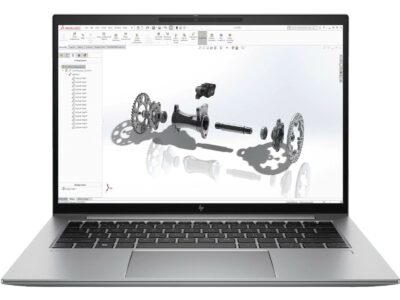If the graphic designer’s job is to communicate ideas, it makes sense that the communication would need to be accurate. Graphic designer skills and abilities rely on accurately presenting information that is free from errors. That’s why in the dynamic realm of graphic design, every pixel matters, and hence, the choice of a laptop becomes a critical decision. Color accuracy and display quality are the pillars upon which breathtaking visual creations stand. This article is your guide to unveiling the best laptops that marry precision and vibrancy, ensuring your graphic design work reaches new heights.
Now let us discuss some of the most important points while considering a laptop for Graphic design work:
1. The Crucial Role of Color Accuracy
When it comes to graphic design, color is more than just a visual element—it’s a language. Designers communicate emotions, messages, and brand identities through color. Color accuracy on a laptop screen ensures that what you see is what you get, eliminating any discrepancies between on-screen and printed colors. A laptop with superior color accuracy is a tool that empowers designers to make informed decisions about their designs.
2. High-Resolution Displays: Bringing Designs to Life
The resolution of a laptop’s display is a defining factor for graphic designers. A higher resolution provides more detail, allowing designers to work on intricate projects with precision. Look for laptops with at least a Full HD (1920×1080) resolution, but for the most demanding tasks, consider models with 4K displays. These high-resolution displays not only bring designs to life but also contribute to a more immersive and enjoyable design experience.
3. IPS Panels: Wide Viewing Angles and True Colors
For graphic designers who require consistent color representation from various angles, laptops equipped with IPS (In-Plane Switching) panels are the go-to choice. IPS technology ensures wide viewing angles and accurate color reproduction, crucial for collaborative work or presentations. A laptop with an IPS panel guarantees that your designs will look stunning and true to life, regardless of the viewing angle.
4. Adobe RGB and sRGB Color Gamuts: Expanding the Design Spectrum
Professional graphic designers often work within specific color gamuts, such as Adobe RGB and sRGB. These color spaces define the range of colors a laptop screen can reproduce. Choosing a laptop with a wide color gamut, particularly covering a significant portion of Adobe RGB and sRGB, ensures that your designs reflect the intended colors accurately. This is especially vital for projects involving print media or digital assets with specific color requirements.
5. Dedicated GPUs: Powering Graphic-Intensive Tasks
The graphic design process often involves working with large files and performing complex rendering tasks. A laptop equipped with a dedicated GPU, such as the NVIDIA GeForce RTX series, accelerates graphic-intensive tasks. This not only enhances the overall performance of design applications but also contributes to a smoother workflow, particularly when handling 3D rendering or high-resolution image editing.
6. Ample RAM: Smooth Multitasking for Design Efficiency
Efficient multitasking is a hallmark of a well-equipped graphic design laptop. Having ample RAM (Random Access Memory), preferably 16GB or more, allows designers to work on multiple design elements simultaneously. This not only reduces lag but also ensures a seamless experience when working with large design files or running resource-intensive design software.
7. Storage Solutions: SSDs for Speedy Access
In the fast-paced world of graphic design, waiting for files to load is not an option. Solid State Drives (SSDs) offer faster data access speeds compared to traditional Hard Disk Drives (HDDs). Opt for a laptop with an SSD to experience speedy file transfers, quick application launches, and an overall responsive design workflow. Consider models with sufficient SSD capacity for your storage needs.
8. Calibration Capabilities: Precision in Color Management
For designers who demand ultimate precision in color management, a laptop with calibration capabilities is indispensable. This feature allows you to calibrate the display to industry standards, ensuring consistent and accurate color reproduction across various devices. Calibration capabilities add a layer of professionalism to your design work, making it suitable for print and digital platforms alike.
9. Durability and Build Quality: Long-Term Investment in Creativity
Investing in a durable laptop is an investment in the longevity of your creative endeavors. A well-built laptop withstands the rigors of daily use, ensuring that it remains a reliable tool in your design journey for years to come. Consider laptops with sturdy construction and quality materials, as they are more likely to endure the demands of a designer’s daily workload.
Conclusion
In the realm of graphic design, the marriage of color accuracy and display quality defines the designer’s experience. The laptops mentioned here, with their emphasis on superior color accuracy, high-resolution displays, wide colour gamut, dedicated GPUs, ample RAM and thoughtful design features, elevate the graphic design experience to new heights. Choosing the right laptop is not just a decision; it’s an investment in your creativity. It is noteworthy that HP provides an excellent choice for graphic design laptops, with the HP Zbook Firefly G10 Mobile Workstation PC being a particularly reliable option. This mobile workstation is meticulously designed, combining potency and lightness to meet the demands of professionals. With its impressive performance and easy portability, the HP ZBook Firefly emerges as the ideal solution for handling challenging tasks while on the go.
Compare and view all the HP laptops for graphic design























